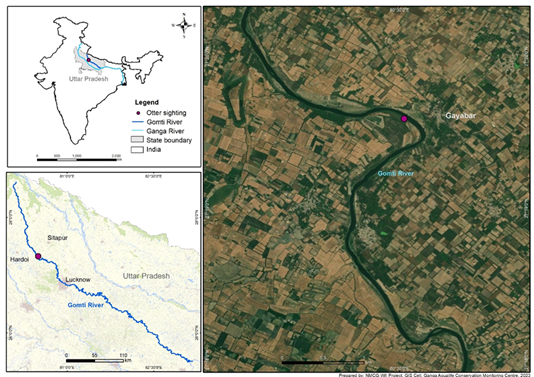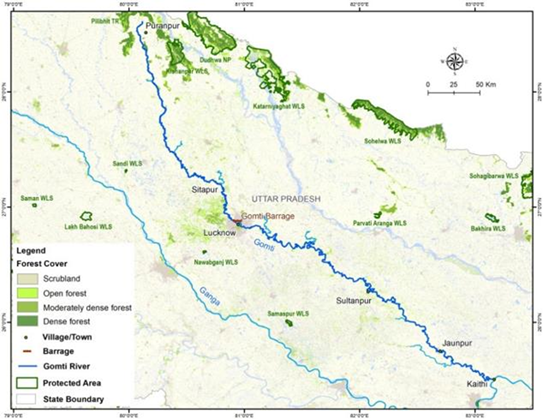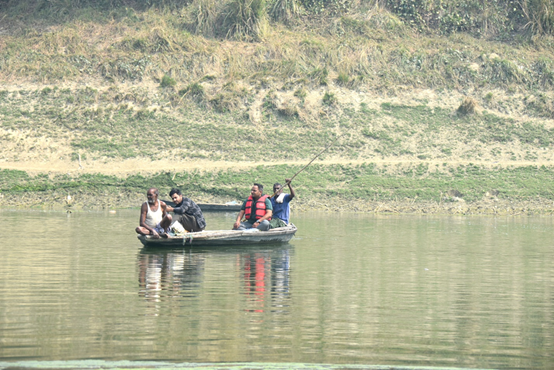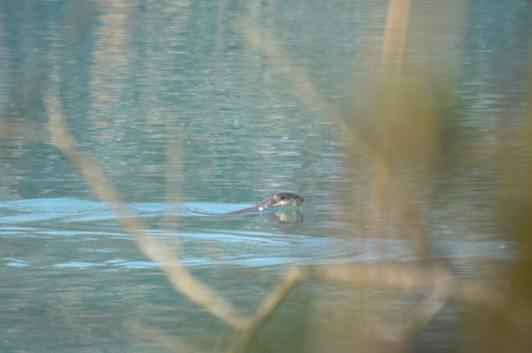IUCN/SSC Otter Specialist Group Bulletin

©IUCN/SCC Otter Specialist Group
Volume 42 Issue 2 (March 2025)
Citation: Maurya, V., Nautiyal, S., Badola, R., And Hussain, S.A. (2025). First Photographic Record of Smooth-Coated Otter Lutrogale perspicillata in Gomti River, Uttar Pradesh, India. IUCN Otter Spec. Group Bull. 42 (2): 85 - 90
First Photographic Record of Smooth-Coated Otter Lutrogale perspicillata in Gomti River, Uttar Pradesh, India
Vipul Maurya, Sumit Nautiyal, Ruchi Badola, and Syed Ainul Hussain
1National Mission for Clean Ganga Project (NMCG), Wildlife Institute of India, Chandrabani, Dehradun, Uttarakhand 248001, India
*Corresponding Author Email: vipulforestry@gmail.com
Received 2nd January 2025, accepted 3rd January 2025
Abstract: The Smooth-coated otter (Lutrogale perspicillata) plays a crucial role as an indicator species and an apex predator in the aquatic ecosystem. This report marks the first sighting of this species in the Gomti River of Uttar Pradesh, supported by photographic evidence. Such records are vital for understanding India's biodiversity and the distribution patterns of species. They contribute significantly to scientific knowledge and inform conservation efforts in the region, emphasizing the importance of monitoring and protecting these essential components of aquatic ecosystems..
Keywords: Lutrogale perspicillata, new record, photographic evidence, Gomti River
INTRODUCTION
Freshwater ecosystems, despite representing a small fraction of the Earth’s surface, harbor about one-third of all vertebrate species, making them exceptionally rich in biodiversity (Dudgeon et al., 2006). However, these ecosystems are increasingly threatened by human-induced changes, such as dam construction, pollution, over-extraction of water, and habitat fragmentation. These changes significantly affect aquatic biodiversity, making freshwater habitats some of the most endangered ecosystems worldwide (Dudgeon et al., 2006; Vörösmarty et al., 2010). Conservation efforts are crucial to mitigate these impacts and protect the unique biodiversity found in freshwater environments. Otters, elusive mammals of the order Carnivora and family Mustelidae (Acharya and Rajbhandari, 2011), are top predators in wetland ecosystems. They thrive in habitats that include intact forests and scrub areas, where they have access to fresh water essential for their feeding needs (Yonzon, 1998; Acharya et al., 2010). Their presence indicates a healthy aquatic ecosystem, as they rely on abundant prey populations and suitable environmental conditions, highlighting their importance in wetland conservation and biodiversity monitoring efforts. Although Smooth-coated otters (Lutrogale perspicillata) are widely distributed (Hussain and Choudhury, 1997), there has been no documented evidence of their presence in the main stem of the Gomti River. This knowledge gap likely results from a lack of comprehensive ecological assessments along the entire length of the Gomti River, from its source to its confluence with the Ganga at Ghazipur. The recent photographic documentation marks the first confirmed sightings of smooth-coated otters in the Gomti, highlighting the need for further ecological studies and conservation efforts in this understudied river system.
OBSERVATION
An ecological assessment funded by the National Mission for Clean Ganga (NMCG), Ministry of Jal Shakti, Government of India, was conducted by the Wildlife Institute of India (WII) in 2023 under the project titled “Planning and Management for Aquatic Species Conservation and Maintenance of Ecosystem Services in the Ganga River Basin for a Clean Ganga.” During this assessment, a single direct sighting of a smooth-coated otter (Lutrogale perspicillata) was recorded in the 929-km-long Gomti River at a location near the Lucknow-Sitapur border of Uttar Pradesh (Fig. 1,3).



The observation was made on March 5, 2023, near the Gomti River (27°19′35.57″N, 80°30′1.87″E). The otter’s appearance, consistent with the description by Gray (1865), featured a dark brown coloration on the upper side and lighter-colored undersides (Fig. 4). This sighting is significant as it represents the first documented evidence of smooth-coated otters in this region, underscoring the importance of continued ecological monitoring and conservation efforts in the Gomti River basin. The Gomti River redistributes the weathered sediments derived from the Himalayas as it flows through the great alluvial fan of the Gangetic plain biogeographic zone (Upper Gangetic Plain – 7A), which is of Pleistocene-Holocene origin (Kumar and Singh, 1978). The upper section of the river is a part of the larger Terai-Arc Landscape and is included in the province of Upper Gangetic Plain 7A (Fig. 2). There is little documented information on the aquatic faunal assemblage of the Gomti River. The area is classified as a Tropical Dry Deciduous Forest according to Champion and Seth (1968). Singh and Chaturvedi (2017) provide a more detailed description, identifying several predominant forest types in this region. These include the northern tropical dry deciduous forest, characterized by species such as Shorea robusta, and the northern dry mixed deciduous forest, dominated by Acacia catechu. Other types include the general edaphic types of dry deciduous forests, featuring species like Butea monosperma and Acacia arabica, and the dry tropical riverine forest, which is home to Terminalia arjuna, Acacia catechu, and Dalbergia sissoo. Additionally, the area contains northern tropical thorn forests, which are composed of species such as Acacia leucophloea, Acacia arabica, Prosopis cineraria, and Zizyphus spp. This diverse mosaic of dry deciduous and thorn forests provides a range of habitats that support various flora and fauna, including species of conservation concern like the smooth-coated otter.
DISCUSSION
Otters, particularly the Smooth-coated otter, face significant threats from habitat destruction due to human activities, such as agricultural expansion that has led to the degradation of vital habitats like wetlands, grasslands, and forests (Ottino and Giller, 2004). In India, there have been limited sightings of otters, with only sporadic reports documenting their presence across various regions (Hinton and Fry, 1923; Pocock, 1940; Chitampalli, 1979). However, a recent sighting brings renewed hope for the survival of this declining population. Given that the smooth-coated otter is considered a threatened species, this new sighting, especially outside of protected areas, presents an opportunity for detailed population studies. Such research could inform and develop effective conservation strategies tailored to the species’ needs in the region (Gupta et al., 2015).
Acknowledgments - The authors express their gratitude to the Chief Wildlife Warden of Uttar Pradesh and the National Mission for Clean Ganga (NMCG) for providing the necessary funding. We are equally thankful to the frontline forest staff, as well as the Divisional Forest Officers (DFO) of Sitapur and Lucknow, for their invaluable support during the survey.
REFERENCES
Acharya, P.M. & S. Rajbhandari. (2011). Distribution and conservation status of otters in Nepal. Zoo Journal 2: 27–37. https://ruffordorg.s3.amazonaws.com/media/project_reports/Distribution%20and%20Conservation%20Status%20of%20Otters%20in%20Nepal.pdf
Acharya, P.M., P. Lamsal, S.L. Rajbhandari, D. Neupane, P. Shrestha, M. Niraula, M. Pathak, H.K. Lama, and& B. Lama (2010). Status and distribution of otters in Narayani River, Chitwan National Park. A first phase research report submitted to Rufford Foundation, UK. 52 pp.
Champion, H.G., and Seth, S.K. (1968). A revised survey of the forest types of India. Government of India Press. New Delhi, India. https://archive.org/details/revisedsurveyoff0000sirh/page/n3/mode/2up
Chitampalli, M.B. (1979). Miscellaneous notes 1. On the occurrence of the common otter in Maharashtra (Itadoh Lake-Bhandara District) with some notes on its habits. J. Bombay Natural History Society 76: 151–152. https://archive.org/details/biostor-147924
Dudgeon, D., Arthington, A.H., Gessner, M.O., Kawabata, Z.-I., Knowler, D.J., Lévêque, C., Naiman, R.J., Prieur-Richard, A.-H., Soto, D., Stiassny, M.L.J. and Sullivan, C.A. (2006). Freshwater biodiversity: importance, threats, status and conservation challenges. Biological Reviews, 81: 163-182. https://doi.org/10.1017/S1464793105006950
Gray, D.J.E. (1865). Revision of the Genera and Species of Mustelidae Contained in the British Museum. Proceedings of the Zoological Society of London, 33: 100–154. https://doi.org/10.1111/j.1469-7998.1865.tb02315.x.
Gupta, N., K. Sivakumar, V.B. Mathur, and M.A. Chadwick (2015). Terrestrial protected areas and managed reaches conserve threatened freshwater fish in Uttarakhand, India. Parks 21(1): 89–101. https://doi.org/10.2305/IUCN.CH.2014.PARKS-21-1NG.en
Hinton, A.C.M., and T.B. Fry (1923). Bombay Natural History Society’s mammal survey of India, Burma and Ceylon. J. Bombay Natural History Society 29: 415–428. https://www.biodiversitylibrary.org/page/47864908
Hussain, S.A., and B.C. Choudhury (1997). Distribution and status of the Smooth-coated Otter Lutra perspicillata in National Chambal Sanctuary, India. Biological Conservation 80: 199–206. https://doi.org/10.1016/S0006-3207(96)00033-X
Kumar, S. & I.B. Singh. (1978). Sedimentological study of Gomti River sediments, Uttar Pradesh, India. Example of a river in alluvial plain. Senckenbergiana Maritima 10(4-6): 145-211. ISBN: 0080-889X https://eurekamag.com/research/019/975/019975929.php?srsltid=AfmBOorh4_qDRIyKj_VpmoVtOG76YQUkU9vMwYx6Jf6Qydqf1cb2zPf3
Ottino, P. and P. Giller. (2004). Distribution, density, diet and habitat use of the otter in relation to land use in the Araglian Valley, southern Ireland. Proceedings of the Royal Irish Academy 104(1): 1-17. https://www.researchgate.net/publication/228853758
Pocock, R.I. (1940). Notes on some British Indian otters, with descriptions of two new subspecies. J. of the Bombay Natural History Society 41(3): 514–517. https://www.biodiversitylibrary.org/page/47818952
Singh, J. S. and R.K. Chaturvedi. (2017). Diversity of ecosystem types in India: A review. Proceedings of the Indian National Science Academy, 83: 569-594. http://dx.doi.org/10.16943/ptinsa/2017/41287
Vörösmarty, C. J., P.B. McIntyre, M.O. Gessner, D. Dudgeon, and A. Prusevich. (2010). Global threats to human water security and river biodiversity. Nature, 467(7315): 555–561. https://doi.org/10.1038/nature09440
Yonzon, P.B. (1998). Baseline information on wildlife of the West Seti River Valley with emphasis on bird and mammals. A report to the West Set Hydro-Electric project. SMEC Ltd., 17 pp.
Résumé: Première Photographie de la Loutre à Pelage Lisse Lutrogale perspicillata dans la Rivière Gomti, Uttar Pradesh, en Inde
La loutre à pelage lisse (Lutrogale perspicillata) joue un rôle crucial en tant qu’espèce indicatrice et prédateur au sommet de l’écosystème aquatique. Ce rapport constitue la première observation de cette espèce dans la rivière Gomti de l’Uttar Pradesh, corroborée par des preuves photographiques. De tels enregistrements sont essentiels pour comprendre la biodiversité de l’Inde et les schémas de répartition des espèces. Ils contribuent de manière significative aux connaissances scientifiques et éclairent les efforts de conservation dans la région, soulignant l’importance de la surveillance et de la protection de ces constituants essentiels des écosystèmes aquatiques.
Revenez au dessus
Resumen: Primer Registro Fotográfico de Nutria Lisa Lutrogale perspicillata en el Río Gomti, Uttar Pradesh, India
La nutria Lisa (Lutrogale perspicillata) juega un rol crucial como especie indicadora y predador tope en el ecosistema acuático. Este reporte informa del primer avistaje de esta especie en el Río Gomti, Uttar Pradesh, con evidencia fotográfica. Este tipo de registros son vitales para entender la biodiversidad de India y los patrones distribucionales de las especies. Contribuyen significativamente al conocimiento científico y dan base informativa a los esfuerzos de conservación en la región, enfatizando la importancia de monitorear y proteger a estos componentes esenciales de los ecosistemas acuáticos.
Vuelva a la tapa
